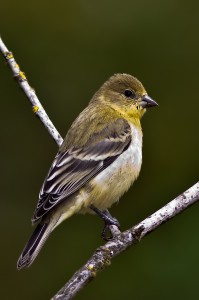Getting Close to Birds
How close you get to your subject has a direct relationship to the quality and sharpness of your bird images. The more pixels the bird has in it, the better. I’m not saying to pass up the shot just because the critter isn’t perched at your lens’s minimum focusing distance! But generally, quality does increase when the bird comes closer to filling the frame (in close up bird photography).
Try being as quiet as you can as you walk or drive around. Don’t make sudden noises or movements. Try standing in one place for at least ten minutes to see if any nearby birds will get used to you being there. Wear earth colors so you blend in better. When walking on gravel trails, walk on the edge where some grass is instead of on the noisy gravel. Listen for the calls and songs of birds. After a while, you’ll be able to identify certain birds by their call/song.
If you’re out on foot and a bird is too far away, try moving closer by zig-zagging toward the bird instead of walking in a straight line to the bird.
Sometimes it’s just plain dumb luck when a bird will land close to you. I remember walking a gravel trail at one of my local refuges on my way back to the parking lot, when this Lesser Goldfinch landed in this small, leafless, tree only fifteen feet away from me. I had my camera on the trusty old monopod over my shoulder, brought it down quietly but quickly, and got this image. [Click on the image for a large view].
From the time I saw the bird land to the time I shot several frames, only 5 to 7 seconds had passed.
Practice a lot and learn from your experience. Techniques that work for me may be different from what works for you.
<<Previous Article Next Article >>
Bird Photography Equipment (1)
DSLR Features for Bird Photography (2)
Lenses for Bird Photography (4)
Bird Photography Accessories (5)
More Accessories for Bird Photography (7)
Software Introduction for Bird Photography (8)
Introduction to Capturing Bird Images (9)
Other Camera Settings and Features (13)
Depth of Field and Aperture (15)
Best Time to Photograph Birds (16)
Composition in Bird Photography (17)
Backgrounds in Bird Photography (19)
Using External Flash when Photographing Birds (20)
Photographing Birds in Flight (21)
Lightroom 3: Hub of my Workflow (22)
Processing Images in Lightroom 3 (23)
Processing Images in Lightroom 3 (24)
From Lightroom to Plugins (25)
Using Lightroom to Upload Images (26)
